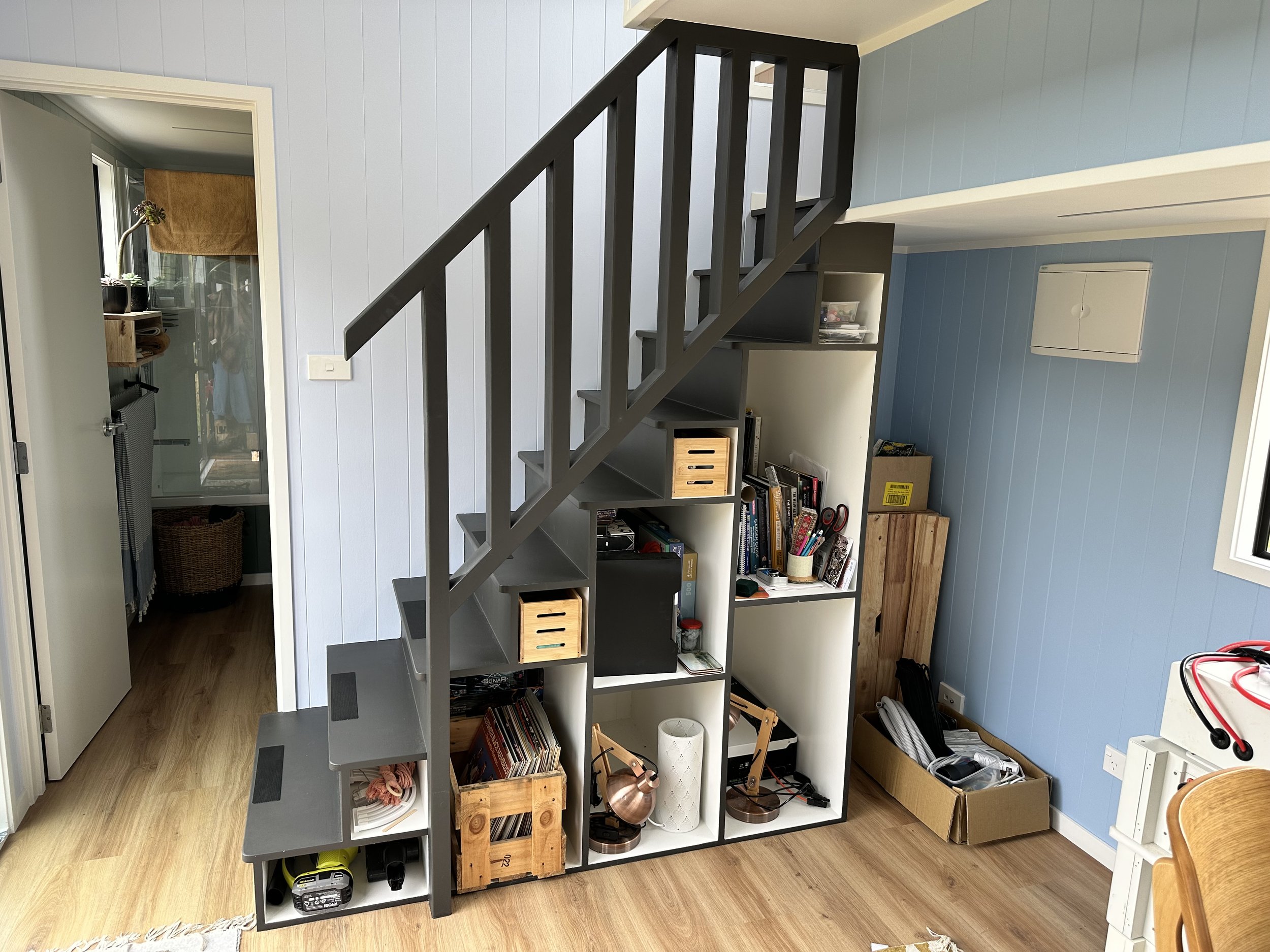Key facts about tiny homes: Compliant vs. Non-Compliant Stairs in Tiny Homes
When designing stairs for tiny homes, compliance with New Zealand’s Building Code Clause D1 (Access Routes) is crucial to ensure safety, comfort, and usability. At Ruru Tiny Homes, we prioritize fully code-compliant stairs that adhere to these regulations, ensuring longevity and accessibility. We do not cut corners by using non-compliant stairs that save space but compromise safety.
Code-Compliant Stairs, Key Features:
✅ Tread Depth (Run): Minimum 280mm
✅ Riser Height: Maximum 190mm
✅ Consistent Risers & Treads: Even spacing and height for predictability
✅ Handrails: Required when stairs rise over 1m
✅ Slip-Resistant Materials: Ensuring a safe grip underfoot
✅ Headroom Clearance: At least 2.0m to prevent head injuries
- Meets Safety Standards: Fully compliant with NZ Building Code
- Comfortable to Use: Each step is deep enough for a full foot landing
- Predictable & Ergonomic: Even spacing reduces trip hazards
- Suitable for All Ages: Easy to navigate for children, adults, and elderly
- Future-Proof: Designed for long-term usability and accessibility
Non-Compliant Stairs, Common Design Shortcuts
❌ Tread Depth Too Small: Often 200mm or less instead of 280mm
❌ Risers Too High: Sometimes over 220mm, making steps steep
❌ Uneven Steps: Irregular heights create tripping hazards
❌ No Handrails: Making falls more likely, especially at night
❌ Lack of Clearance: Low headroom increases risk of head injuries
Why Some people decide to use Non-Compliant Stairs:
- Saves Floor Space: Shallower, steeper stairs leave more room for living areas
- Easier to Build: Simpler to construct than fully compliant stairs
- Cheaper: Requires less material and labor
However, these space-saving designs come at a significant cost to safety.
Disadvantages of Non-Compliant Stairs, General Issues:
- Increased Fall Risk: Steep and shallow steps make tripping more likely
- Difficult for Everyday Use: Can be tiring and uncomfortable
- Unsafe for Children: Small treads make it hard for little feet to balance
- No Future-Proofing: As mobility decreases with age, unsafe stairs become a major problem
- Non-Code Compliance Risks: Could cause issues with council approvals, insurance, and resale value
Impact on Older People
For older individuals, non-compliant stairs significantly increase health and safety risks:
🚨 Balance & Stability Issues: Aging reduces balance, making steep stairs dangerous
🚨 Joint & Mobility Challenges: High risers are difficult for those with knee or hip issues
🚨 Increased Fall Severity: Falls from stairs are among the leading causes of injuries in older adults
🚨 Lack of Handrails: Without a handrail, catching yourself during a fall is nearly impossible
🚨 Potential for Future Accessibility Problems: Non-compliant stairs might require expensive modifications later
Aging in place requires foresight, and poorly designed stairs make this impossible.
Why Ruru’s Code-Compliant Stairs Are Safe & Future-Proof for Older People
Ruru Tiny Homes builds stairs not just for today, but for the future. Our designs ensure that homeowners can continue using their stairs safely and comfortably as they age.
✅ Ergonomic Design: Easy, gradual rise prevents strain on joints
✅ Wider & Deeper Treads: Ensures full-foot placement for balance
✅ Handrails Always Installed: Offering essential support for stability
✅ Predictable & Uniform Steps: Prevents the risk of tripping
✅ Slip-Resistant Materials: Minimizes risks in all weather conditions
✅ Headroom Clearance Maintained: Prevents head injuries
By designing for the long term, we future-proof homes, making them safe for all ages and stages of life.
Safety First, Always: While space-saving, non-compliant stairs might seem like a clever solution, they pose serious safety risks, especially for older individuals. Ruru Tiny Homes’ fully code-compliant stairs provide comfort, safety, and long-term usability, making them a smart, future-proof investment.
Choosing compliant stairs today means choosing safety, ease, and peace of mind for years to come.



